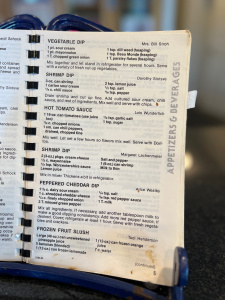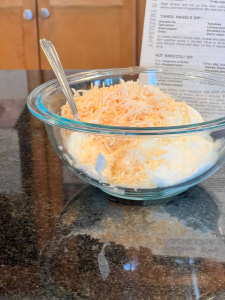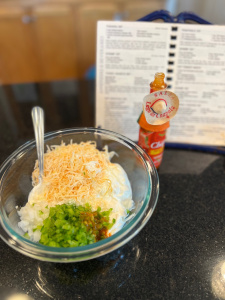Food for Fun in the Sun: Part I
Over the gloriously long Fourth of July weekend, my family did our favorite things:
Cook
Eat
Swim
Bike
Read
Repeat, in no particular order.
Long, lazy afternoons require good snacks, I thought, and so I explored the “Appetizers & Beverages” section more thoroughly.
Peppered Cheddar Dip
As we enjoy cheese with spice, my first selection was “Peppered Cheddar Dip,” submitted by Alice Westby. This was great, as expected, because Mrs. Westby taught home economics, later called family and consumer science, in Velva, knows a lot about cooking, and is an excellent cook and baker.

This was a very clear recipe, with easy-to-follow instructions and defined ingredients (cheddar cheese, not the generic “cheese” category occasionally encountered in these pages).

I mixed all the ingredients together, and as recommended, added another tablespoon of milk to “make a good dipping consistency.” Other than adding a teaspoon of hot sauce initially, rather than the one-eight of a teaspoon specified, the only liberty I took was to use the Mexican-style blend cheese in my fridge because it was already shredded, included cheddar, and blended well with hot sauce in previous recipes. I appreciated the lack of processed ingredients.

I covered it and placed it in the fridge for three and a half hours to blend. When I tasted it before serving it, I thought it could use a bit more spice; I was worried that the extra milk had over-powered it. Moreover, I decided to add half a cup more cheddar, and this time I grated sharp white cheddar in case my blend was too mild. I also added another two tablespoons of hot sauce—this time a garlic-flavored hot sauce—and a teaspoon of salt and pepper.

We enjoyed this very much and agreed that it got better the longer it sat and blended. It was particularly delicious the next day. Alice’s advice to “refrigerate at least 1 hour” is astute. As recommended, I served it with fresh vegetables and a variety of crackers; the cool dip was particularly refreshing on a warm day in the sun.


Contributor: Alice Westby
Alice Westby grew up on her family’s farm south of Bowdon, ND, a town about an hour and thirty minutes southeast of Velva. When we met for an interview, she noted that her parents, Kenneth and Beulah Long, both liked to cook and bake and shared those duties in their home. After graduating from NDSU with a degree in home economics education, she taught in Butte for one year, Anamoose and Drake for two years, and then in Velva for 35 years. During her time in Velva, her teaching responsibilities included secondary home economics (later the field was renamed family and consumer science) for the first thirty years, as well as Spanish language education for about twenty years, with the final five years teaching Spanish full time. Her husband John, also from Bowdon, studied electrical engineering at NDSU and worked at Verendrye Electric Cooperative in Velva. They retired to Bismarck, ND, near their two children, Joanna and Philip, and seven grandchildren. In retirement, Alice noted that they are gardening and cooking a lot, and like her parents, both are fond of cooking: John enjoys making stir-fry dishes, Alice does the baking, and they both share grilling responsibilities. Alice mentioned that she is baking more now and is pleased about that, as she’s always loved it. In her home economics classes, the yeast-bread unit was always one of her favorite units to teach. After her retirement from teaching, Alice also served as a Family Community and Wellness Agent for the Burleigh County Office of NDSU Extension.
To find recipes, Alice said that she still uses The Joy of Sharing, as well as her shelves of cookbooks and also the internet when she wants to find a recipe for a particular ingredient or dish quickly. She still makes the peppered cheddar dip she contributed in 1985, as well as Pat Beyer’s wild rice casserole. She told me that the other recipe she contributed, “Cheesy Potato Bake,” coincided with a foodway trend of the mid-1980s—the popularity of dishes made in the microwave. Alice pointed out that both The Joy of Sharing and the cookbook published around the same time by the Velva Jaycettes included sections for microwave dishes and that microwave cooking had become part of her curriculum at that time. According to A History of Velva, published in 2005, by the Star City Centennial Committee, Velva’s female branch of the Jaycees civic organization started in the 1970s, held a popular talent show in the 1980s, and “worked toward business and civic improvements” (55). Later in that decade it disbanded.
As the home economics/family and consumer science teacher, Alice was the advisor for the Velva Chapter of the Future Homemakers of America (FHA) and later, the Velva Chapter of the Family, Career and Community Leaders of America (FCCLA), after the national organization (originally established in 1945) changed its name from FHA to FCCLA in 1999, a change corresponding to the discipline’s renaming. As advisor, Alice supervised the production of two more Velva community cookbooks published by Morris Press: the Velva School and Community Cookbook in 1993, and the Velva School & Community Centennial Cookbook: A Collection of Recipes by Velva FCCLA and Star City Centennial Committee in 2004. And I can say from personal experience that she was an excellent educator and advisor; Mrs. Westby was one of my favorite teachers, and I loved her home ec classes and Spanish classes, as well as traveling with her to the FHA national convention in New Orleans to compete with my parliamentary procedure team. When I got married, she gave us the most wonderful gift—a dish towel embroidered with chili peppers and the phrase “La Cocina de Karla y Lukas.” It is sitting in my dishtowel drawer, and I smile every time I grab it.
There is a lot more to say about these other Velva community cookbooks, as well as the fascinating history of FHA, FCCLA, New Homemakers of America (NHA), and the disciplines of home economics and family and consumer sciences, as well as their intersections with cooking, the history of cookbooks, gendered division of labor, sexism, racism, the changing nature of work in the US, family structures, and so on. I’m eager to get to all of this, but it’s going to take more space—an essay, a chapter, a book…there’s more to come!
This post is part of an ongoing series in which I make and reflect on recipes and the people who contributed them to the 1985 Oak Valley Lutheran Church compiled cookbook, The Joy of Sharing.

